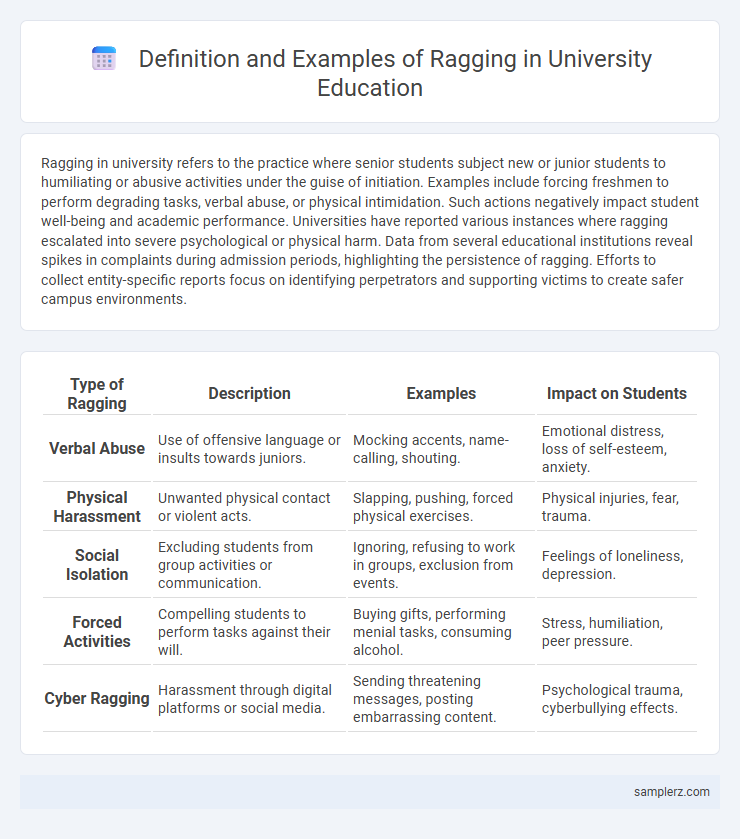Ragging in university refers to the practice where senior students subject new or junior students to humiliating or abusive activities under the guise of initiation. Examples include forcing freshmen to perform degrading tasks, verbal abuse, or physical intimidation. Such actions negatively impact student well-being and academic performance. Universities have reported various instances where ragging escalated into severe psychological or physical harm. Data from several educational institutions reveal spikes in complaints during admission periods, highlighting the persistence of ragging. Efforts to collect entity-specific reports focus on identifying perpetrators and supporting victims to create safer campus environments.
Table of Comparison
| Type of Ragging | Description | Examples | Impact on Students |
|---|---|---|---|
| Verbal Abuse | Use of offensive language or insults towards juniors. | Mocking accents, name-calling, shouting. | Emotional distress, loss of self-esteem, anxiety. |
| Physical Harassment | Unwanted physical contact or violent acts. | Slapping, pushing, forced physical exercises. | Physical injuries, fear, trauma. |
| Social Isolation | Excluding students from group activities or communication. | Ignoring, refusing to work in groups, exclusion from events. | Feelings of loneliness, depression. |
| Forced Activities | Compelling students to perform tasks against their will. | Buying gifts, performing menial tasks, consuming alcohol. | Stress, humiliation, peer pressure. |
| Cyber Ragging | Harassment through digital platforms or social media. | Sending threatening messages, posting embarrassing content. | Psychological trauma, cyberbullying effects. |
Psychological Impact: Real-Life Cases of Ragging
Ragging incidents at universities often result in severe psychological trauma, including anxiety, depression, and post-traumatic stress disorder (PTSD) among victims. For example, a documented case at a prominent Indian university highlighted how prolonged hazing rituals led to a student's withdrawal from academics and social isolation. Studies reveal that the fear of ragging significantly affects students' mental health, impairing their academic performance and overall well-being.
Physical Abuse: Disturbing University Ragging Incidents
Physical abuse in university ragging incidents often involves severe acts such as beatings, forced physical exercises, and humiliating physical tasks imposed on freshmen. These disturbing cases result in serious injuries, psychological trauma, and sometimes long-term disabilities among victims, highlighting the urgent need for strict anti-ragging policies and enforcement. Documented examples include students being physically assaulted in hostels, leading to hospitalization and intervention by campus authorities.
Humiliation and Bullying: Student Experiences with Ragging
Ragging in universities often involves severe humiliation and bullying, where senior students subject juniors to verbal abuse, forced servitude, and public embarrassment. These experiences lead to intense psychological trauma, affecting students' academic performance and mental health. Documented cases reveal that ragging fosters a hostile campus environment, undermining student well-being and safety.
Ragging During Freshers’ Week: Notable Examples
Ragging during Freshers' Week often involves seniors forcing new students to perform humiliating tasks or engage in physical abuse, leading to severe psychological trauma. Notable examples include cases where freshers were subjected to night-long interrogations, forced consumption of alcohol, and public humiliation ceremonies in Indian universities. Such incidents have prompted strict legal actions and anti-ragging helplines, emphasizing the urgent need for institutional vigilance and student awareness programs.
Seniors’ Power Play: Common Ragging Practices in Universities
Seniors in universities often exert dominance through ragging practices like physical intimidation, forced consumption of alcohol, and public humiliation to establish authority over juniors. These acts create a hostile environment, impacting students' mental health and academic performance. Understanding these common ragging techniques is essential to develop effective anti-ragging policies and promote campus safety.
Hazing Rituals: Infamous University Ragging Scenarios
Hazing rituals in universities often involve senior students forcing juniors to perform humiliating tasks, such as physical endurance tests, public shaming, or excessive alcohol consumption, creating a toxic environment. Notorious cases include the University of Delhi, where ragging led to severe psychological trauma and even student deaths, highlighting the gravity of such practices. These incidents emphasize the urgent need for strict anti-ragging policies and awareness campaigns in educational institutions worldwide.
Gender-Based Ragging: True Stories from Campuses
Gender-based ragging in universities often targets female students through verbal harassment, threats, and forced participation in degrading activities, impacting their mental health and academic performance. True stories from campuses reveal instances where senior male students intimidate juniors by enforcing gender-specific humiliations, such as inappropriate physical contact or sexist remarks. These experiences highlight the urgent need for strict anti-ragging policies and gender-sensitive counseling services to protect students and create safer educational environments.
Online Ragging: Cyberbullying in the University Setting
Online ragging in universities often involves cyberbullying through social media platforms, group chats, and anonymous messaging apps. Victims may face harassment such as offensive messages, sharing of embarrassing photos, and exclusion from online academic groups, which severely impacts their mental health and academic performance. Universities increasingly implement strict anti-cyberbullying policies and provide digital counseling services to address and mitigate online ragging incidents.
Regional Ragging Incidents: Statewise Examples Across Campuses
In Tamil Nadu, reports of ragging have frequently surfaced at Anna University, where senior students force juniors to perform humiliating tasks under peer pressure. West Bengal's Jadavpur University has witnessed incidents involving verbal abuse and physical harassment during induction weeks, impacting freshmen's mental health. Maharashtra's Mumbai University recorded cases where seniors imposed strenuous physical activities on new entrants, raising concerns about campus safety and student well-being.
Legal Consequences: Notorious Ragging Cases and Their Outcomes
Notorious ragging cases in universities have led to stringent legal actions, including imprisonment and cancellation of enrollment for perpetrators. Courts have upheld severe penalties under anti-ragging laws such as the Prohibition of Ragging Act, with landmark cases resulting in convictions that serve as precedents. These legal consequences emphasize the judiciary's commitment to eradicating ragging and protecting student rights within educational institutions.

example of ragging in university Infographic
 samplerz.com
samplerz.com